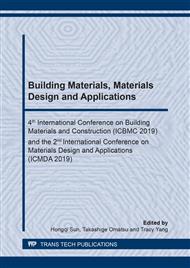[1]
P. Sharmila, G. Dhinakaran: Compressive Strength, Porosity and Sorptivity of Ultra Fine Slag based High Strength Concrete. Construction and Building Materials, 120 (2016), pp.48-53.
DOI: 10.1016/j.conbuildmat.2016.05.090
Google Scholar
[2]
S.S. Kaprielov, A.V. Sheynfeld, D. Al-Omais, A.S. Zaitsev: High-Strength Concretes in Constructions of Foundations of the High-Rise Complex OKO" in MIBC "Moscow-City". Promyshlennoe i Grazhdanskoe Stroitelstvo [Industrial and Civil Engineering], 3 (2017) pp.53-57. URL: https://elibrary.ru/item.asp,id=28868869.
Google Scholar
[3]
M. Kharun, D. Koroteev: Effect of Basalt Fibres on the Parameters of Fracture Mechanics of MB Modifier based High-Strength Concrete. MATEC Web of Conferences, 251 (2018).
DOI: 10.1051/matecconf/201825102003
Google Scholar
[4]
T. Ponikiewski, J. Gołaszewski: The Rheological and Mechanical Properties of High-performance Self-Compacting Concrete with High-Calcium Fly Ash. Procedia Engineering 65 (2013), pp.33-38.
DOI: 10.1016/j.proeng.2013.09.007
Google Scholar
[5]
M.M. Kamal, M.A. Safan, Z.A. Etman, M.A. Abd-Elbaki: Effect of steel fibers on the properties of recycled self-compacting concrete in fresh and hardened state. International Journal of Civil Engineering, 13(4A) (2015), pp.400-410.
Google Scholar
[6]
M. Kharun, Y.V. Nikolenko, N.A. Stashevskaya, D.D. Koroteev: Thermal Treatment of Self-Compacting Concrete in Cast-In Situ Construction. Key Engineering Materials, 753 (2017), pp.315-320.
DOI: 10.4028/www.scientific.net/kem.753.315
Google Scholar
[7]
Y.V. Nikolenko, M.M. Manaeva, N.A. Stashevskaya: About the Technology of Concreting in Cast-in-Situ Building Construction. RUDN Journal of Engineering Researches, 4 (2014), pp.84-89. URL: https://elibrary.ru/item.asp?id=22697370.
Google Scholar
[8]
A.I. Shesternin, M.O. Korovkin, N.A. Eroshkina: Fundamentals of Self-Compacting Concrete Technology. Molodoi Uchenyi [Young Scientist], 6(86) (2015), pp.226-228. URL: https://elibrary.ru/item.asp?id=23172170.
Google Scholar
[9]
A.P. Svintsov, Y.V. Nikolenko, N.N. Patrakhaltsev, V.N. Ivanov: Improving the Technology of Concreting Work in the Cast-in-Situ Building Construction. Stroitel'nye Materialy [Construction Materials], 1 (2012), pp.28-31. URL: https://elibrary.ru/item.asp?id=17337048.
Google Scholar
[10]
G. Bumanis, N. Toropovs, L. Dembovska, D. Bajare, A. Korjakins: The Effect of Heat Treatment on the Properties of Ultra High Strength Concrete, Proceedings of the 10th International Scientific and Practical Conference, Rezekne, Latvia (2015), pp.22-27.
DOI: 10.17770/etr2015vol1.209
Google Scholar
[11]
M.K. Yew, H. Bin Mahmud, B.C. Ang, M.C. Yew: Effects of Heat Treatment on Oil Palm Shell Coarse Aggregates for High Strength Lightweight Concrete. Materials & Design, 54 (2014), pp.702-707.
DOI: 10.1016/j.matdes.2013.08.096
Google Scholar
[12]
C. Sivathanu Pillai, A.R. Santhakumar, S. Chandrasekaran, S. Viswanathan, R. Mathiyarasu, J.A. Kumar, R. Preetha, B. Venkatraman: Effect of Heat Treatment on Neutron Attenuation Characteristics of High Density Concretes (HDC). Progress Nuclear Energy, 93 (2016), pp.76-83.
DOI: 10.1016/j.pnucene.2016.08.003
Google Scholar
[13]
R. Derabla, M.L. Benmalek: Characterization of Heat-Treated Self-Compacting Concrete Containing Mineral Admixtures at Early Age and in the Long Term. Construction and Building Materials, 66 (2014), pp.787-794.
DOI: 10.1016/j.conbuildmat.2014.06.029
Google Scholar
[14]
B. Höhlig, C. Schröfl, S. Hempel, I. Noack, V. Mechtcherine, D. Schmidt, U. Trommler, U. Roland: Heat Treatment of Fresh Concrete by Radio Waves – Avoiding Delayed Ettringite Formation. Construction and Building Materials, 143 (2017), pp.580-588.
DOI: 10.1016/j.conbuildmat.2017.03.111
Google Scholar
[15]
Z. Shui, D. Xuan, H. Wan, B. Cao: Rehydration Reactivity of Recycled Mortar from Concrete Waste Experienced to Thermal Treatment. Construction and Building Materials, 22(8) (2008), pp.1723-1729.
DOI: 10.1016/j.conbuildmat.2007.05.012
Google Scholar
[16]
K. Pandurangan, A. Dayanithy, S. Om Prakash: Influence of Treatment Methods on the Bond Strength of Recycled Aggregate Concrete. Construction and Building Materials, 120 (2016), pp.212-221.
DOI: 10.1016/j.conbuildmat.2016.05.093
Google Scholar
[17]
H.K.A. Al-Bayati, P.K. Das, S.L. Tighe, H. Baaj: Evaluation of Various Treatment Methods for Enhancing the Physical and Morphological Properties of Coarse Recycled Concrete Aggregate. Construction and Building Materials, 112 (2016), pp.284-298.
DOI: 10.1016/j.conbuildmat.2016.02.176
Google Scholar
[18]
GOST 10180-2012. CIS Interstate Standard. Concretes: Methods for Strength Determination using Reference Specimens (Standartinform, Moscow, Russia 2013). URL: http://gostexpert.ru/gost/gost-10180-2012.
Google Scholar


